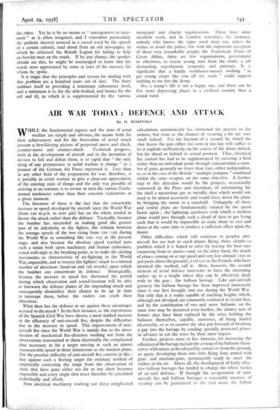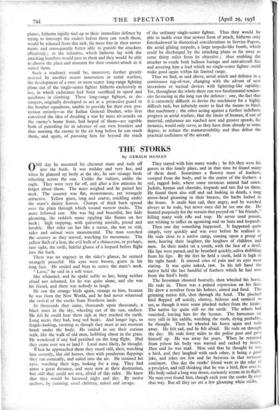AIR WAR TODAY: DEFENCE AND ATTACK
By H. ROSINSKI
WHILE the fundamental aspects and the aims of aerial warfare are simple an.4:1 obvious, the means both for their achievement and for the frustration of aerial attack present a bewildering picture of perpetual move and check, counter-move and counter-check. Technical progress, both in the development of aircraft and in the invention of devices to foil and defeat them, is so rapid that "the only thing of any permanence in aerial warfare is change" as a pioneer of the German Air Force expressed it. Less than in any other field of the preparation for war, therefore, it is possible in aerial warfare to give a clear-cut appreciation of the existing state of things and the only way possible of arriving at an estimate is to review in turn the various funda- mental tendencies rather than their concrete realisations at a given moment.
The foremost of these is the fact that the remarkable increase in speed developed by aircraft since the World War (from 120 m.p.h. to over 400) has on the whole tended to favour the attack rather than the defence. Tactically, because the bomber has succeeded in making good the greater part of its inferibrity to the fighter, the relation between the average speeds of the two rising from too : 150 during the World War to something like too : 115 at the present stage, and also because the absolute speed reached puts such a strain both upon machinery and human endurance, tested well-nigh to the breaking point, as to make the circling movements, so characteristic of air-fighting in the World War, impossible, and to restrict the fighters' attack to a limited number of directions (head-on and tail attacks) upon which the bomber can concentrate its defence. Strategically, because the increase in speed has shortened the period during which observation and sound-location will be able to forewarn the defence planes of the impending attack and consequently diminishes their chance to be up in time to intercept them, before the raiders can reach their objectives.
What then has the defence to set against these advantages accrued to the attack ? In the first instance, as the experiences of the Spanish Civil War have shown, a most marked increase in the efficiency of anti-aircraft fire, despite the difficulties due to the increase in speed. This improvement of anti- aircraft fire since the World War is mainly due to the intro- duction of mechanical fire-directors working out from the observations transmitted to them electrically the complicated data necessary to hit a target moving at such an almost inconceivable speed in three dimensions as the modern plane. For the peculiar difficulty of anti-aircraft fire consists in this : that against such a fleeting target the ordinary method of empirically correcting the range from the observation of shots that have gone either too far or too short becomes impossible and every single shot must therefore be calculated individually and afresh.
Now electrical machinery working out these- complicated calculations automatically has shortened the process to the utmost, but even so the chances of securing a hit are very small indeed. For the fraction of a second by which the shot leaves the gun either too soon or too late will suffice to let it explode ineffectively, on the course of the plane indeed, but far ahead or behind its actual position. Thus, electrical fire control has had to be supplemented by covering a field rather than an individual point through concentrating a num- ber of guns, generally no fewer than four, either independent, or, as in the case of the British" multiple pompon "combined within the same weapon, on the same objective. A further step in this direction would be the projects, occasionally rumoured in the Press and elsewhere, of substituting for the shell a mysterious gas or metallic dust which would not need to be aimed accurately and would force down the plane by bringing the motor to a standstill. Unhappily all these and similar plans are fundamentally vitiated by the speed factor again ; the lightning quickness with which a modern plane would pass through such a cloud of dust or gas being such that it would be impossible to make them so vast and dense at the same time to produce a sufficient effect upon the motor.
Other difficulties which still continue to perplex anti- aircraft fire are how to catch planes flying above clouds—a problem which it is hoped to solve by tracing the heat rays emanating from its motor—and, on the other hand, the attack of planes coming on at top speed and very low altitude (200 to 300 yards above the ground), a vol rase as the French, who have invented this method, call it. Here, however, the second element of aerial defence intervenes to force the oncoming raiders up to a height where they can be effectively dealt with by the gun ; the balloon barrage. Like anti-aircraft gunnery the balloon barrage has been improved immensely since it was first brought into use during the World War. Not only that it is today capable of reaching heights which, although not divulged, are commonly estimated at 12,000 feet, and by the combination of two and more balloons on the same wire may be increased even further, the clumsy nets of former days have been replaced by the wires holding the balloons themselves, capable, moreover, of being loaded electrically, so as to counter the idea put forward of breaking a gap into the barrage by sending specially protected planes in advance to cut the wires by their mere impact.
Further, projects more or less fantastic, for increasing the efficiency of the barrage include the arming of the balloons them- selves with mines, to be released by contact or from the ground, or again, developing them into little flying forts armed with guns and machine-guns, permanently ready to meet the raiders in the air. Above all, the development of fairly effec- tive balloon barrages has tended to change the whole tactics of air-raid defence. If through the co-operation of anti- aircraft fire and balloon barrages a reasonable measure of security can be guaranteed to the vital areas, the fighter planes, hitherto rigidly tied up to their immediate defence by trying to intercept the raiders before these can reach them, would be released from this task, far more free in their move- ments and consequently better able to punish the attackers effectively ; as the initiative, which hitherto Jay with the attacking bombers would pass to them and they would be able to choose the place and moment for their counter-attack as it suited them.
Such a tendency would be, moreover, further greatly assisted by another recent innovation in aerial warfare, the development of a two- or more seater long-range fighting plane out of the single-seater fighter hitherto exclusively in use, in which endurance had been sacrificed to speed and quickness in climbing. These long-range fighters, or de- stroyers, originally developed to act as a protective guard to the bomber squadrons, unable to provide for their own pro- tection entirely—as the Italian General Douhet, who first conceived the idea of deciding a war by mass air-attacks on the enemy's home front, had hoped of them—are. capable both of patrolling far in advance of our own frontiers and thus meeting the enemy in the air long before he can reach them, and again, of pursuing him far beyond the reach of the ordinary single-seater fighter. Thus they would be able to tackle even that newest form of attack, hitherto only foreshadowed in theoretical considerations in Service Papers, the aerial gliding torpedo, a large torpedo-like bomb, which could be discharged by the attacking plane as far away as some thirty miles from its objective ; thus enabling the attacker to evade both balloon barrage and anti-aircraft fire and assuring him a lead which no single-seater fighter could make good again within his limited range.
Thus we find, as said above, aerial attack and defence in a continuous tug-of-war, changing with the advent of new inventions or tactical devices with lightning-like rapidity. Yet, throughout the whole there run two fundamental tenden- cies favouring in the long run the defence : one, the fact that it is extremely difficult to devise the machinery for a highly difficult task, but infinitely easier to find the means to block that ,machinery ; the other acting against a further indefinite progress in aerial warfare, that the limits of human, if not of material, endurance are reached now and greater speeds, for instance, would only serve, as they have done already to some degree, to reduce the manoeuvrability and thus defeat the practical usefulness of the aircraft.



























































 Previous page
Previous page